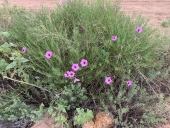I'm going to try and attach some pictures that I took today, as well as what I've whipped up on QGIS. Is it better to host photos somewhere else and then reference them here?
Here is what I noticed today:
As I walk through the channel, I notice that there is some channelization happening, but only in part of the channel, as featured here:
So vegetation seems to grow more abundantly where the water is flowing more directly. It might be nice to spread that out via a leaky dam. There is actually a ton of vegetation growing up in the upper portion of the channel, right before the property line ends. This channel clearly hasn't had significant flow for a while. However, if there is going to be flow, about 450 acres empties through this channel. So perhaps one day in the future the flow will be big.







